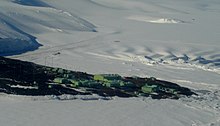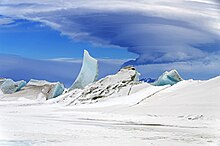Scott Base
Scott Base | |
|---|---|
Antarctic base | |
 Aerial photograph of Scott Base looking towards Observation Hill. | |
 Scott Base Location of Scott Base in Antarctica | |
| Coordinates: 77°50′57″S 166°46′06″E / 77.849132°S 166.768196°ECoordinates: 77°50′57″S 166°46′06″E / 77.849132°S 166.768196°E | |
| Country | |
| Location in Antarctica | Ross Island Ross Dependency Antarctica |
| Administered by | Antarctica New Zealand |
| Established | 20 January 1957 |
| Named for | Captain Robert Falcon Scott, RN |
| Elevation | 10 m (30 ft) |
| Population | |
| • Total |
|
| Time zone | UTC+12 (NZST) |
| • Summer (DST) | UTC+13 (NZDST) |
| Type | All year-round |
| Period | Annual |
| Status | Operational |
| Website | antarcticanz.govt.nz/scott-base |
Scott Base is a New Zealand Antarctic research facility at Pram Point on Ross Island near Mount Erebus in New Zealand's Ross Dependency territorial claim. The research facility was named in honour of Captain Robert Falcon Scott, RN, leader of two British expeditions to the Ross Sea area of Antarctica. The base was set up as support to field research and the centre for research into earth sciences, and now conducts research in many fields, operated by Antarctica New Zealand.
The base is 3 kilometres (1.9 mi) from the larger U.S. McMurdo Station via Pegasus Road.
History[]
This article needs additional citations for verification. (April 2020) |




Scott Base was originally constructed in support of the UK inspired and privately managed Commonwealth Trans-Antarctic Expedition (TAE). The New Zealand government provided support for the TAE and also for the International Geophysical Year (IGY) project of 1957, five of whose members were attached to the Expedition. In February 1956, 10 months before the TAE and IGY parties were due to head to the Antarctic, Frank Ponder, an architect at the Ministry of Works (New Zealand), was given the task of designing the base. Ponder's design consisted of six main buildings and three smaller scientific labs. The main buildings were to be placed at least 7 metres apart because of fire risk but were linked to one another by a covered way of galvanised iron. Three New Zealand observers who were also given the task of selecting the site for a base went to McMurdo Sound with the United States "Operation Deep Freeze I" in the summer of 1955. After evaluating possible sites, a location near Butter Point was chosen. This was later changed to Pram Point as it provided better access for offloading supplies from the Expedition ship HMNZS Endeavour and also allowed for the operation of the critical RNZAF Antarctic Flight on a nearby ice runway. The base looks out over what is now known as Haskell Strait. Scott Base passed over to New Zealand Government ownership via the Department of Scientific and Industrial Research (DSIR), on 5 March 1958, at the conclusion of the TAE.
During the IGY the United States facility at Hut Point did not operate as a scientific base. It was the New Zealand expedition’s responsibility to furnish the important scientific data (auroral, ionospheric, seismic, etc.), linking the McMurdo area research activities with those of the United States Pole Station and the joint United States-New Zealand station at Cape Hallett, Victoria Land.
In 1958, following completion of the TAE and IGY, New Zealand made the decision to continue to operate Scott Base for scientific research, much of which depends upon the continuity of recorded data over a period of years. In order to maintain operations, a base rebuilding programme began in 1976. As of 2008, the only original building is the TAE 'A' mess hut, which contains material recording New Zealand's involvement in Antarctica since 1957. In 2005 the two-story high Hillary Field Centre was commissioned, increasing the floor area of Scott Base by 1800 square metres and providing work areas to support field parties as well as additional office space. The building was officially opened by then-Foreign Minister Phil Goff and Sir Edmund Hillary.
The leader of Scott Base for the 1964-65 season, Adrian Hayter, published a personal memoir of his experience.[2] He was preceded as Leader by Russell Rawle[3] and followed by Mike Prebble.[4] These three leaders are commemorated with Rawle Glacier, Mount Hayter and Prebble Glacier, assuming the leader in 1965-66 was on the base support party of 1961-62.
From 1957 until 1986, dogs played a part in base operations. Initially, they were an essential means of transport, but with better technology, their importance dwindled until they were removed in line with environmental treaties.
Scientific diving operations began in 1985.[5] Between 1985 and 2006, a total of 1,296 had been logged.[6]
Historic site[]
The A Hut of Scott Base is the only existing Commonwealth Trans-Antarctic Expedition (1956–1957) building in Antarctica. It has been designated a Historic Site or Monument (HSM 75), following a proposal by New Zealand to the Antarctic Treaty Consultative Meeting.[7]
The base today[]
The base is made up of a collection of Chelsea Cucumber green[8] buildings which are linked by all-weather corridors. These buildings can accommodate 85 people over summer, with a "skeleton staff" of between 10 and 14 people remaining over the winter.
Like nearby McMurdo Station, Scott Base is connected to the global telephone network via a Satellite Earth Station operated by Spark New Zealand, located approximately 3 kilometres (1.9 mi) away at Arrival Heights. Spark NZ also provide phone services to McMurdo[citation needed] for calls to New Zealand as well as to the Italian Programme at Terra Nova Bay. McMurdo Station has an independent communications infrastructure located at Black Island and linked to Ross Island via microwave. In support of the future of New Zealand’s Antarctic science programme, the base will be redeveloped. In June 2019 the Government committed NZ$18.5 million (US$12.4 million) for the next phase of the Scott Base Redevelopment project, which will see the base's 12 separate buildings replaced by three large interconnected buildings. [9][10] Jasmax and Hugh Broughton Architects came up with the architectural design.[11] Since then the New Zealand Government has committed $344 million to rebuild the base.[12]
Scott Base is today operated by Antarctica New Zealand. Three Enercon E-33 wind turbines (330 kilowatts (440 hp) each) were installed in 2009 to co-power Scott Base and McMurdo Station, reducing diesel consumption by 11%: 463,000 litres (102,000 imp gal; 122,000 US gal) per year.[13][14]
Climate[]

A polar ice cap climate with evenly-distributed precipitation (Köppen EFf) prevails at Scott Base. The base has fairly typical weather conditions for coastal Antarctica, with minimum temperatures around −45 °C (−49 °F) and summer maximum only occasionally above freezing point. It is exposed to the full strength of southerly blizzards, although overall it is less windy than McMurdo Station. The maximum wind velocities experienced have been gusts up to 185 kilometres per hour (115 mph) with steady velocities under blizzard conditions of 95–115 kilometres per hour (59–71 mph). The highest recorded temperature was 6.8 °C (44.2 °F), the coolest −57 °C (−71 °F) and the mean temperature −19.6 °C (−3.3 °F).[15]
| hideClimate data for Scott Base (1981−2010) | |||||||||||||
|---|---|---|---|---|---|---|---|---|---|---|---|---|---|
| Month | Jan | Feb | Mar | Apr | May | Jun | Jul | Aug | Sep | Oct | Nov | Dec | Year |
| Average high °C (°F) | −1.2 (29.8) |
−8.0 (17.6) |
−15.9 (3.4) |
−18.7 (−1.7) |
−20.0 (−4.0) |
−20.1 (−4.2) |
−22.5 (−8.5) |
−23.4 (−10.1) |
−21.3 (−6.3) |
−15.6 (3.9) |
−7.2 (19.0) |
−1.2 (29.8) |
−14.6 (5.7) |
| Daily mean °C (°F) | −4.5 (23.9) |
−11.6 (11.1) |
−20.6 (−5.1) |
−24.2 (−11.6) |
−25.7 (−14.3) |
−26.0 (−14.8) |
−28.7 (−19.7) |
−30.0 (−22.0) |
−27.6 (−17.7) |
−20.8 (−5.4) |
−11.3 (11.7) |
−4.5 (23.9) |
−19.6 (−3.3) |
| Average low °C (°F) | −7.9 (17.8) |
−15.3 (4.5) |
−25.3 (−13.5) |
−29.7 (−21.5) |
−31.4 (−24.5) |
−31.9 (−25.4) |
−34.9 (−30.8) |
−36.6 (−33.9) |
−34.0 (−29.2) |
−26.0 (−14.8) |
−15.3 (4.5) |
−7.9 (17.8) |
−24.7 (−12.5) |
| Average precipitation mm (inches) | 18 (0.7) |
21 (0.8) |
14 (0.6) |
16 (0.6) |
23 (0.9) |
22 (0.9) |
13 (0.5) |
12 (0.5) |
11 (0.4) |
13 (0.5) |
12 (0.5) |
9 (0.4) |
184 (7.2) |
| Source 1: NIWA Climate Data[16] | |||||||||||||
| Source 2: Weatherbase[17] | |||||||||||||
See also[]
- List of Antarctic expeditions
- List of Antarctic research stations
- List of Antarctic field camps
- Marble Point
- Castle Rock (Antarctica)
- Ross Ice Shelf
- The Antarctic Sun
- Williams Field
- Crime in Antarctica
References[]
- ^ Jump up to: a b "Scott Base". Antarctica New Zealand. New Zealand Government. 2016. Retrieved 11 July 2016.
- ^ Hayter, Adrian. The Year of the Quiet Sun: One year at Scott Base, Antarctica: a personal impression. Hadder and Stoughton, 1968, London, p. 76
- ^ Hayter, p.31.
- ^ Hayter, p. 181
- ^ Mercer, Steve (2000). "Antarctic lake diving with the semi-closed rebreather". In: Hallock and French (Eds). Diving for Science...2000. Proceedings of the 20th Annual Scientific Diving Symposium, American Academy of Underwater Sciences. St Pete Beach, Florida. Retrieved 8 June 2013.
- ^ Pollock, Neal W (2007). "Scientific diving in Antarctica: history and current practice". Diving and Hyperbaric Medicine. 37: 204–11. Retrieved 8 June 2013.
- ^ "List of Historic Sites and Monuments approved by the ATCM (2012)" (PDF). Antarctic Treaty Secretariat. 2012. Retrieved 6 January 2014.
- ^ http://www.scottbase50years.co.nz/faq/faq2.htm
- ^ "Redeveloping Scott Base for the future". Antartctic. 37: 13. 2019.
- ^ "Home". Scott Base Redevelopment. Retrieved 7 March 2021.
- ^ Morton, Jamie (28 June 2019). "Plans for new-look Scott Base revealed". NZ Herald. Retrieved 15 July 2019.
- ^ https://www.scottbaseredevelopment.govt.nz/news-publications/successful-budget-for-scott-base
- ^ "Ross Island Wind Energy". Antarctica New Zealand. New Zealand Government. 2016. Retrieved 28 September 2015.
- ^ "New Zealand Wind Energy Association". Wind Energy. Archived from the original on 17 November 2013. Retrieved 6 November 2013.
- ^ Mackintosh, Lesley (2013). "How cold is the Antarctic?". NIWA. Retrieved 11 July 2016.
- ^ "Temperature Data and Activities". NIWA. 28 February 2007. Retrieved 19 October 2013.
- ^ "Precipitation Data". Weatherbase. Retrieved 3 May 2020.
External links[]
- Antarctica New Zealand homepage
- Scott base homepage
- Antarctic connection page
- Current weather at Scott Base
- Current webcam at Scott Base
- Images & Articles about Antarctica from New Zealand Defence Force
- COMNAP Antarctic Facilities
- COMNAP Antarctic Facilities Map
Scott Base 50th Anniversary Website
NZ Antarctic Research
- Outposts of Antarctica
- Scott Base
- Outposts of the Ross Dependency
- Historic Sites and Monuments of Antarctica
- 1957 establishments in Antarctica

